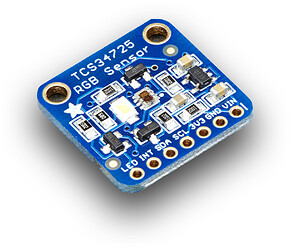Hello everyone,
I am really new to Arduino, so sorry, if i ask noob questions here.
i am planning to connect the color sensor adafruit TCS34725 (https://eu.mouser.com/datasheet/2/737/TCS34725-932784.pdf) to my arduino micro and i would like to transform the captured data into midi CC messages. So this thing should act like a MIDI-USB Device.
First i have a question about the wiring:
Here are my connections:
VIN to 5V
Gnd to Gnd
SDA to 2
SCL to 3
Is this correct? Here is a link to my arduino board pdf: https://content.arduino.cc/assets/Pinout-Micro_latest.pdf
Later i would like to include buttons and potentiometers, but i thought, at first i need to make this work. So i first just try to get Data from the Sensor.
So i copied this CODE and uploaded it.
MODERATOR EDIT- added code tags
#include "Wire.h"
#include "Adafruit_TCS34725.h"
/* Example code for the Adafruit TCS34725 breakout library */
/* Connect SCL to analog 5
Connect SDA to analog 4
Connect VDD to 3.3V DC
Connect GROUND to common ground */
/* Initialise with default values (int time = 2.4ms, gain = 1x) */
// Adafruit_TCS34725 tcs = Adafruit_TCS34725();
/* Initialise with specific int time and gain values */
Adafruit_TCS34725 tcs = Adafruit_TCS34725(TCS34725_INTEGRATIONTIME_700MS, TCS34725_GAIN_1X);
void setup(void) {
Serial.begin(9600);
if (tcs.begin()) {
Serial.println("Found sensor");
} else {
Serial.println("No TCS34725 found ... check your connections");
while (1);
}
// Now we're ready to get readings!
}
void loop(void) {
uint16_t r, g, b, c, colorTemp, lux;
tcs.getRawData(&r, &g, &b, &c);
colorTemp = tcs.calculateColorTemperature(r, g, b);
lux = tcs.calculateLux(r, g, b);
Serial.print("Color Temp: "); Serial.print(colorTemp, DEC); Serial.print(" K - ");
Serial.print("Lux: "); Serial.print(lux, DEC); Serial.print(" - ");
Serial.print("R: "); Serial.print(r, DEC); Serial.print(" ");
Serial.print("G: "); Serial.print(g, DEC); Serial.print(" ");
Serial.print("B: "); Serial.print(b, DEC); Serial.print(" ");
Serial.print("C: "); Serial.print(c, DEC); Serial.print(" ");
Serial.println(" ");
}
But i dont get any data. Any idea why?
I know this code was initially written for Arduino uno. And i found out (but also not sure), that this wire.h library is not for micro boards. Is that the problem? And how can i solve this?
Many many thanks in advance!
Norbert

